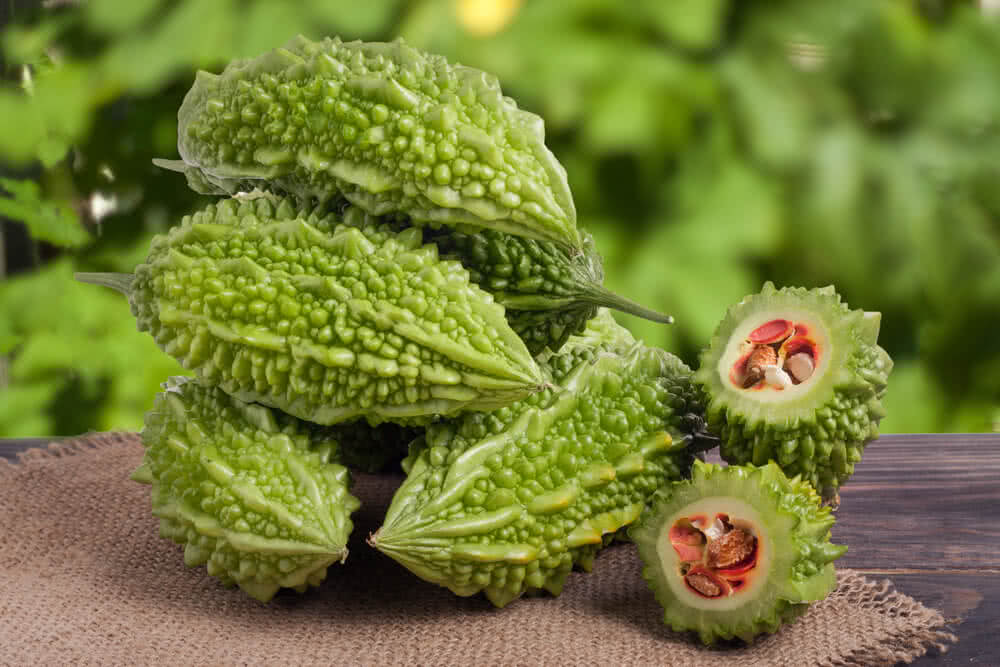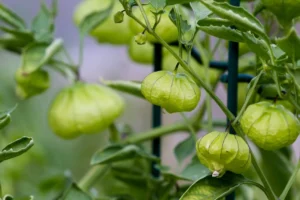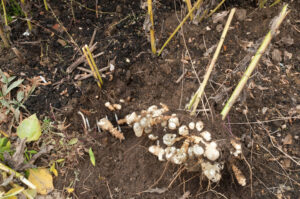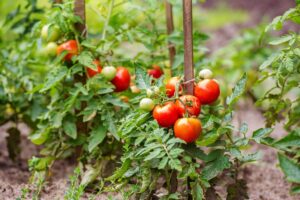How to Grow Momordica charantia (Bitter Melon): A Complete Guide
Momordica charantia, commonly known as bitter melon, bitter gourd, or bitter squash, is a unique tropical and subtropical vine of the Cucurbitaceae family. With its distinctively warty, oblong fruit and impressive nutritional profile, bitter melon has gained popularity in the United States as more people discover its culinary applications and potential health benefits. Whether you’re an experienced gardener or a curious novice, this comprehensive guide will walk you through everything you need to know about growing this fascinating plant in your garden, in containers, or even indoors.
Understanding Bitter Melon (Momordica charantia)
Before diving into cultivation techniques, it’s helpful to understand what makes bitter melon unique. According to the USDA Agricultural Research Service, Momordica charantia is a warm-season annual vine that produces fruit with a distinct bitter flavor, prized in many Asian, Caribbean, and African cuisines. The plant thrives in hot, humid conditions similar to its native tropical regions of Asia, Africa, and the Caribbean.
As the name suggests, bitter melon has a characteristically bitter taste due to the presence of a compound called momordicin. Despite its bitterness (or perhaps because of it), the fruit has become increasingly popular in the US market, where consumers are exploring more diverse and international vegetables.
Bitter Melon Varieties for the US Market
Several varieties of bitter melon can be grown successfully in the United States, each with slightly different characteristics:
| Variety | Appearance | Bitterness Level | Days to Maturity | Best Growing Regions |
|---|---|---|---|---|
| Chinese Bitter Melon | Light green, oblong with warty skin | High | 65-70 days | Southeast, Southwest, California |
| Indian Bitter Melon | Dark green, narrower with pointed ridges | Very high | 70-75 days | Southeast, South |
| Thai Bitter Melon | Small, light green with mild warts | Medium | 60-65 days | Most warm regions |
| White Bitter Melon | Pale white/green, smoother skin | Mild to medium | 70-80 days | Southeast, Hawaii |
| Okinawa Green | Long, dark green with prominent ridges | Medium | 65-70 days | Southeast, Hawaii, Florida |
Growing Bitter Melon from Seed

Seed Preparation and Selection
Starting bitter melon from seed is the most common and economical approach. For the best results:
- Source quality seeds: Purchase seeds from reputable suppliers that specialize in Asian vegetables or rare herbs. According to the USDA National Plant Germplasm System, quality seeds are essential for good germination rates.
- Seed preparation: Bitter melon seeds have a hard coat that benefits from pre-treatment. Soak your seeds in warm water for 24 hours before planting to encourage faster germination.
- Timing matters: Start seeds indoors 4-6 weeks before the last expected frost in your area. Bitter melon requires a long growing season (at least 75-100 days of warm weather).
Starting Seeds Indoors
When starting bitter melon seeds indoors:
- Use biodegradable pots (3-4 inches) filled with seed-starting mix.
- Plant seeds 1/2 inch deep, with 2-3 seeds per pot.
- Place in a warm location (80-85°F is ideal) or use a seed-starting heat mat.
- Keep the soil consistently moist but not waterlogged.
- Seeds typically germinate within 5-10 days when conditions are optimal.
- Once seedlings develop their first true leaves, thin to the strongest plant per pot.
Growing Bitter Melon in Garden Beds
Bitter melon can be a productive addition to your garden when given the right conditions.
Site Selection and Soil Preparation
- Location: Choose a full-sun location that receives at least 6-8 hours of direct sunlight daily.
- Soil requirements: Bitter melon prefers well-draining, fertile soil with a pH between 5.5 and 6.7.
- Soil preparation: Work 2-3 inches of compost or well-rotted manure into your garden soil before planting to improve fertility and drainage.
- Timing: Transplant seedlings outdoors only when all danger of frost has passed and soil temperatures remain consistently above 65°F.
Planting and Spacing
- Spacing: Plant bitter melon seedlings 12-18 inches apart in rows that are 5-6 feet apart.
- Trellising: Install a sturdy trellis, fence, or other vertical support at planting time. Bitter melon vines can grow 12-15 feet long and perform best when given vertical support.
- Watering: Water thoroughly after transplanting and apply a 2-inch layer of organic mulch around plants (keeping it away from stems) to conserve moisture and suppress weeds.
Ongoing Garden Care
- Watering: Provide consistent moisture, aiming for about 1-1.5 inches of water per week. Water at the base of plants to keep foliage dry.
- Fertilizing: Apply a balanced organic fertilizer (like 10-10-10) when plants begin to vine, then again when flowering starts.
- Training: Gently guide young vines onto their support structure as they grow.
- Pruning: Optional but beneficial – prune side shoots to encourage the main vine to reach the top of the trellis, then allow side shoots to develop for greater fruit production.
Growing Bitter Melon in Containers
If you have limited garden space or want to grow bitter melon on a patio or balcony, container growing is an excellent option.
Container Selection and Setup
- Container size: Choose a large container at least 12-15 inches deep and 12-18 inches in diameter. Five-gallon buckets with drainage holes work well.
- Potting mix: Use a high-quality potting mix enriched with compost. The ideal mix provides good drainage while retaining adequate moisture.
- Support structure: Install a trellis or cage in the container at planting time. Container-grown bitter melon still needs vertical support.
Container Growing Tips
- Placement: Position containers where they will receive 6-8 hours of sunlight daily.
- Watering: Container plants dry out faster than garden plants. Check soil moisture daily and water when the top inch feels dry.
- Fertilizing: Apply a diluted liquid organic fertilizer every 2-3 weeks during the growing season.
- Temperature management: Move containers to protected locations if temperatures drop unexpectedly.
Growing Bitter Melon Indoors
While challenging, it is possible to grow bitter melon indoors with the right setup.
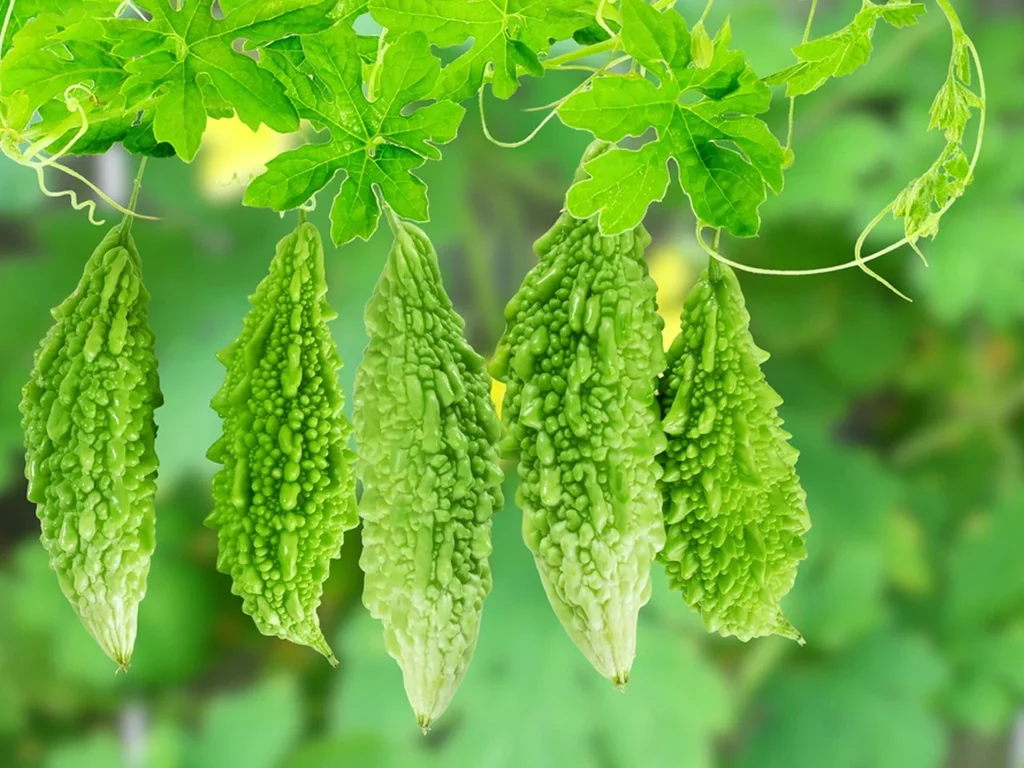
Indoor Growing Requirements
- Light: Bitter melon needs significant light to produce fruit indoors. Place plants near a south-facing window and supplement with grow lights providing 12-14 hours of light daily.
- Temperature: Maintain temperatures between 75-85°F during the day and no lower than 65°F at night.
- Humidity: Create higher humidity by grouping plants together, using a humidifier, or placing containers on pebble trays filled with water.
- Pollination: Indoor plants require hand pollination. Use a small paintbrush to transfer pollen from male flowers (those with thin stems) to female flowers (with tiny fruit behind the flower).
Indoor Growing Setup
- Choose dwarf varieties when possible for indoor growing.
- Use a 7-10 gallon container with excellent drainage.
- Install a sturdy trellis or use stakes to support the vine.
- Rotate the container regularly to ensure even growth and light exposure.
Common Challenges and Solutions
Growing bitter melon can present some challenges, but most can be overcome with proper care:
Pest Management
- Common pests: Aphids, cucumber beetles, spider mites, and pickleworms can affect bitter melon.
- Prevention: Use floating row covers until flowering and inspect plants regularly.
- Treatment: For small infestations, use insecticidal soap or neem oil. For larger problems, consult your local extension office for recommended treatments that comply with USDA organic standards.
Disease Prevention
- Common diseases: Powdery mildew, downy mildew, and viral diseases can affect bitter melon.
- Prevention: Provide good air circulation, avoid overhead watering, and plant in well-draining soil.
- Treatment: Remove and dispose of infected plant parts. Apply organic fungicides early at the first sign of disease.
Harvesting and Using Your Bitter Melon
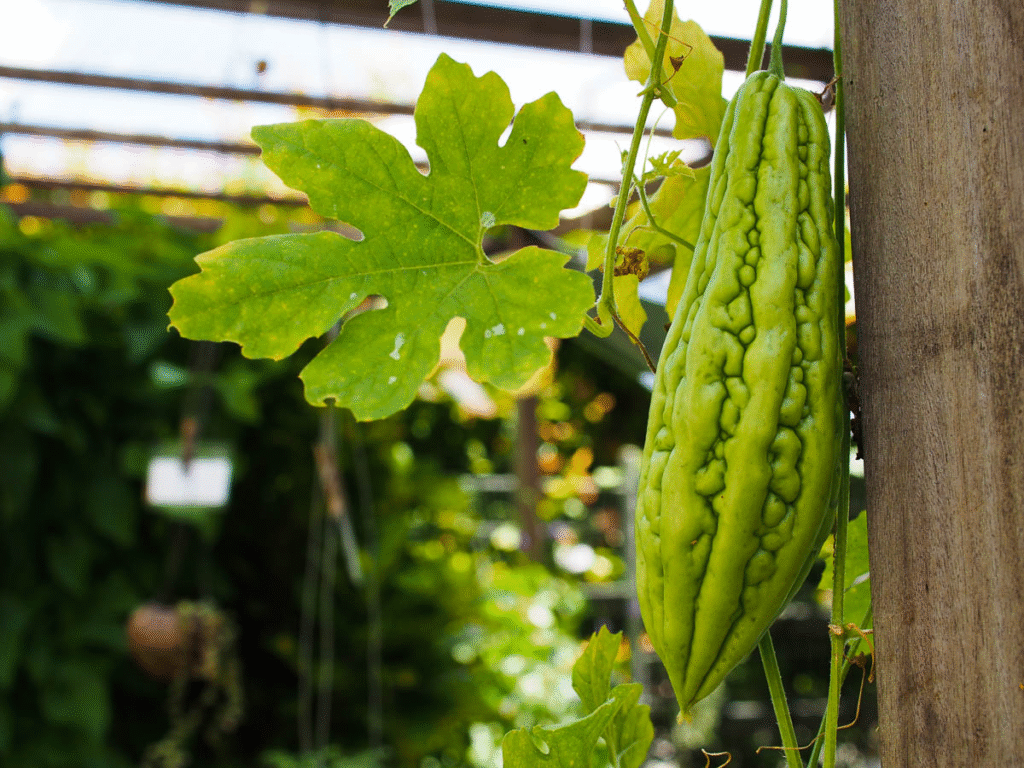
When and How to Harvest
- Timing: Harvest bitter melon when fruits are still immature, typically 12-15 days after flowering. The ideal size depends on variety but is generally 4-6 inches long for Chinese types and 6-8 inches for Indian types.
- Visual cues: Look for firm fruits with bright color (green or white depending on variety). The fruit should have distinct ridges or warts but still feel firm.
- Harvesting technique: Use clean, sharp scissors or pruning shears to cut the fruit from the vine, leaving a small portion of stem attached.
Storing Your Harvest
- Short-term storage: Bitter melon can be stored in the refrigerator for up to a week. Place unwashed fruit in a perforated plastic bag in the crisper drawer.
- Long-term storage: Bitter melon can be blanched and frozen for later use. Some gardeners also dehydrate sliced bitter melon for tea.
Seed Saving
If you’d like to save seeds for next year:
- Allow one or two fruits to fully ripen on the vine until they turn yellow or orange and begin to split open.
- Scoop out the seeds, which will be covered in a bright red aril (covering).
- Clean the seeds by removing the red covering, then rinse and dry thoroughly.
- Store dried seeds in a cool, dry place in a paper envelope.
Culinary Uses of Bitter Melon
Bitter melon’s distinctive flavor makes it a unique addition to your culinary repertoire:
- Reducing bitterness: If the strong bitter flavor is too intense, slice the fruit, sprinkle with salt, and let sit for 15-30 minutes before rinsing and using in recipes.
- Cooking methods: Bitter melon can be stir-fried, stuffed, curried, or added to soups. It pairs well with strong flavors like garlic, chili, coconut milk, and fermented black beans.
- Nutritional benefits: According to the USDA FoodData Central, bitter melon is low in calories and rich in vitamins A and C, folate, and various antioxidants.
Conclusion
Growing Momordica charantia (bitter melon) can be a rewarding experience that connects you with culinary traditions from around the world. While it requires specific growing conditions and a bit of extra care, the unique fruits and potential health benefits make it worth the effort. Whether you choose to grow it in your garden, in containers, or indoors, following the guidelines in this article will help you successfully cultivate this fascinating plant.
By incorporating bitter melon into your garden and kitchen, you’re not only growing a nutritious vegetable but also participating in the increasingly diverse American food landscape. As interest in international cuisines continues to grow in the US market, having fresh bitter melon at your fingertips allows you to explore new flavors and cooking techniques right from your home garden.
